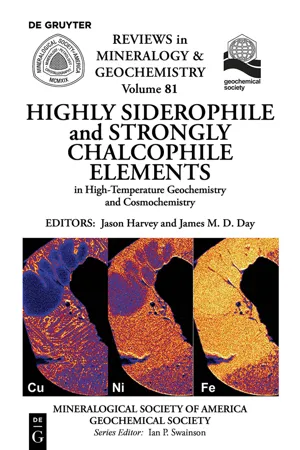
Highly Siderophile and Strongly Chalcophile Elements in High-Temperature Geochemistry and Cosmochemistry
- 797 pages
- English
- PDF
- Available on iOS & Android
Highly Siderophile and Strongly Chalcophile Elements in High-Temperature Geochemistry and Cosmochemistry
About This Book
Highly Siderophile and Strongly Chalcophile Elements in High Temperature Geochemistry and Cosmochemistry, Volume 81
This RiMG (Reviews in Mineralogy & Geochemistry) volume investigates the application of highly siderophile (HSE) and strongly chalcophile elements. This volume has its origin in a short course sponsored by the Mineralogical Society of America and the Geochemical Society held in San Diego, California on the 11 th and 12 th December 2015, ahead of the American Geophysical Union's Fall Meeting, which featured a session with the same title.
Topics in this volume include:
-
- analytical methods and data quality
-
- experimental constraints applied to understanding HSE partitioning
-
- nucleosynthetic variations of siderophile and chalcophile elements
-
- HSE in the Earth, Moon, Mars and asteroidal bodies
-
- HSE and chalcophile elements in both cratonic and non-cratonic mantle, encompassing both sub-continental and sub-oceanic lithosphere
-
- the importance of the HSE for studying volcanic and magmatic processes, and an appraisal of the importance of magmatic HSE ore formation in Earth's crust.
-
Highly siderophile and strongly chalcophile elements comprise Re, Os, Ir, Ru, Pt, Rh, Pd, Au, Te, Se and S and are defined by their strong partitioning into the metallic phase, but will also strongly partition into sulfide phases, in the absence of metal. The chemical properties of the HSE mean that they are excellent tracers of key processes in high temperature geochemistry and cosmochemistry, having applications in virtually all areas of earth science. A key aspect of the HSE is that three long-lived, geologically useful decay systems exist with the HSE as parent ( 107 Pd- 107 Ag), or parent-daughter isotopes ( 187 Re- 187 Os and 190 Pt- 186 Os).
The material in this book is accessible for graduate students, researchers, and professionals with interests in the geochemistry and cosmochemistry of these elements, geochronology, magmatic ore bodies and the petrogenesis of platinum-group minerals.
Frequently asked questions
Information
Table of contents
- Table of Contents
- 1. Experimental Results on Fractionation of the Highly Siderophile Elements (HSE) at Variable Pressures and Temperatures duri g Planetary and Magmatic Differentiation
- 2. Analytical Methods for the Highly Siderophile Elements
- 3. Nucleosynthetic Isotope Variations of Siderophile and Chalcophile Elements in the Solar System
- 4. Highly Siderophile Elements in Earth, Mars, the Moon, and Asteroids
- 5. Distribution and Processing of Highly Siderophile Elements in Cratonic Mantle Lithosphere
- 6. Highly Siderophile Element and 187Os Signatures in Non-cratonic Basalt-hosted Peridotite Xenoliths: Unravelling the Origin and Evolution of the Post-Archean Lithospheric Mantle
- 7. Re–Pt–Os Isotopic and Highly Siderophile Element Behavior in Oceanic and Continental Mantle Tectonites
- 8. Chalcophile and Siderophile Elements in Mantle Rocks: Trace Elements Controlled By Trace Minerals
- 9. Petrogenesis of the Platinum-Group Minerals
- 10. Mantle Sulfides and their Role in Re–Os and Pb Isotope Geochronology
- 11. Highly Siderophile Element and Os Isotope Systematics of Volcanic Rocks at Divergent and Convergent Plate Boundaries and in Intraplate Settings
- 12. Highly Siderophile and Strongly Chalcophile Elements in Magmatic Ore Deposits